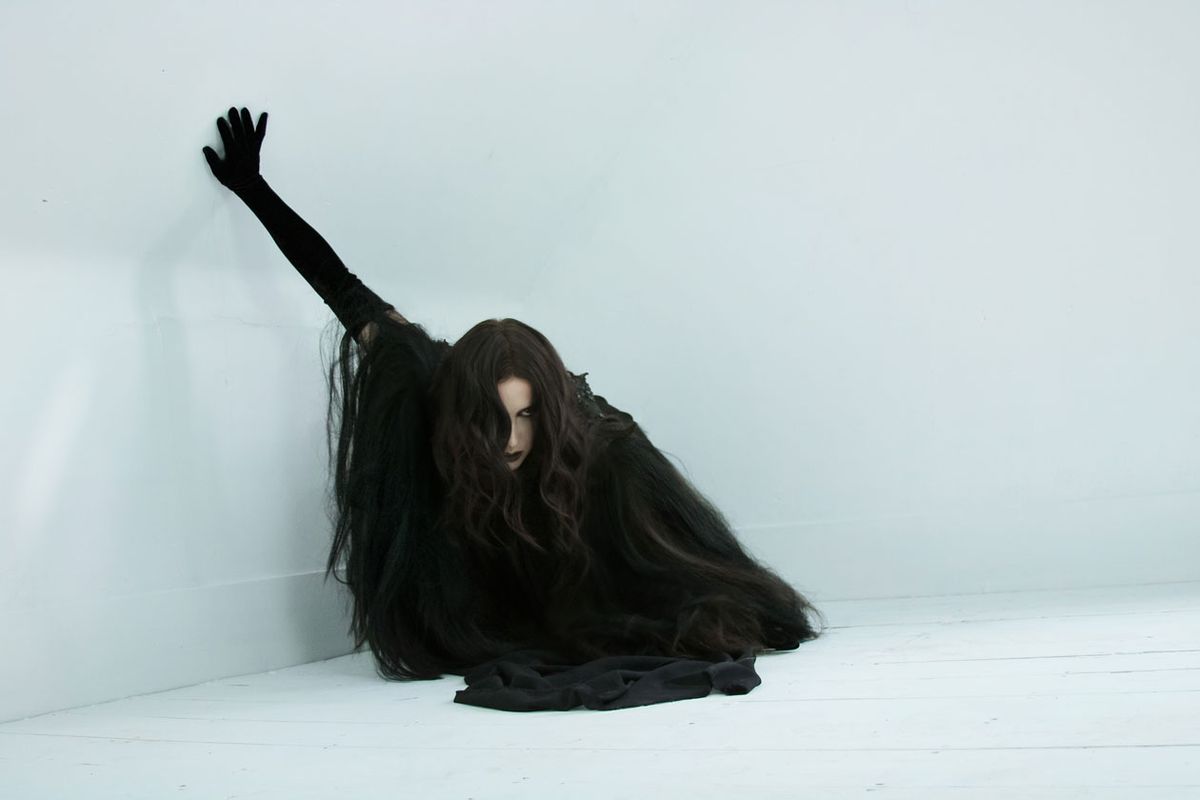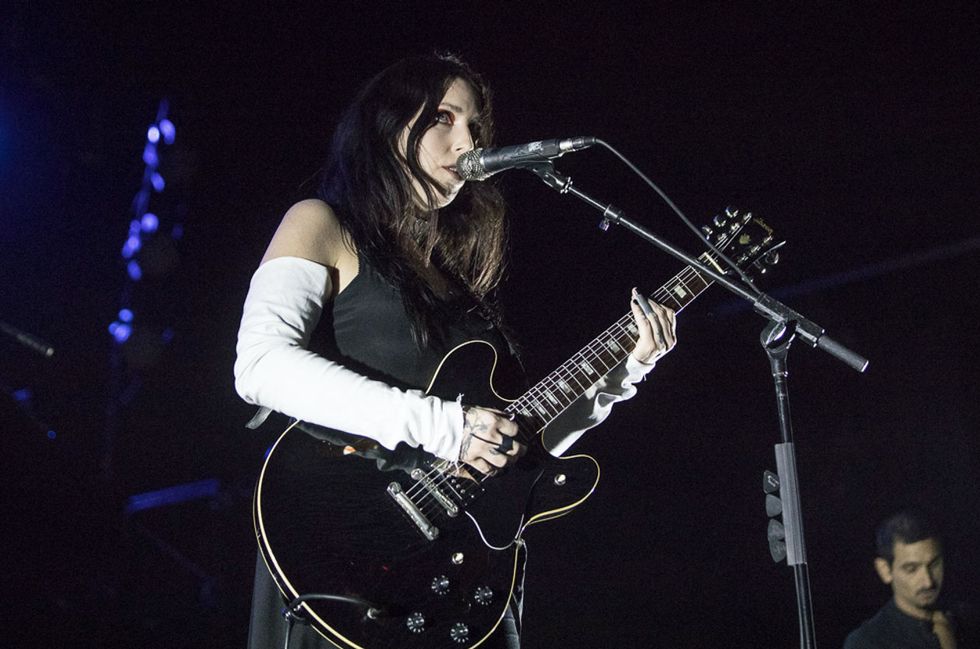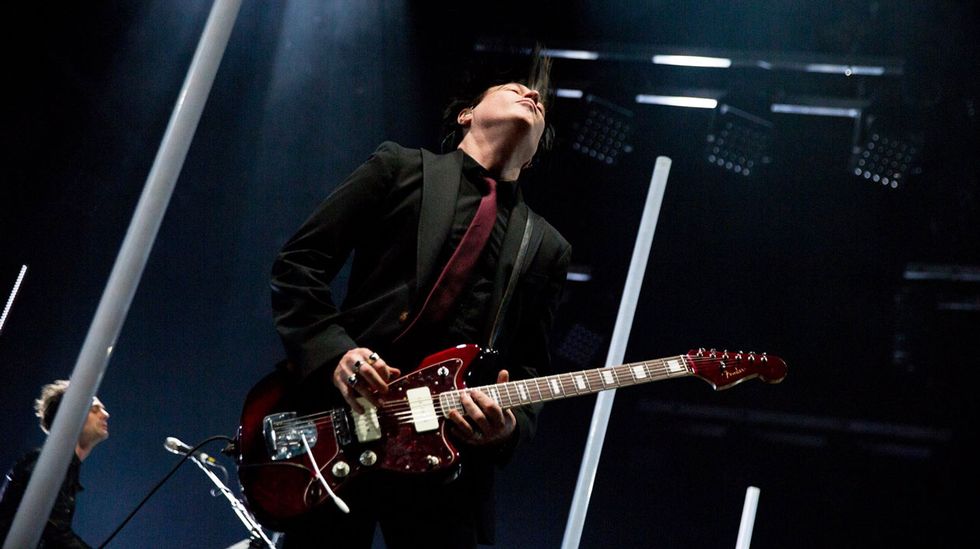Making the radical noise and gorgeous melodies for the supernatural sound of her new album, Hiss Spun, required Gibsons, Fenders, gnarly pedals, guest Troy Van Leeuwen, and a tip from Carl Sagan.
Chelsea Wolfe’s music has morphed and evolved within a sonic realm of her own design—an artistic space that houses everything from intimate acoustic-guitar-driven sounds to bludgeoning industrial assaults to doom-tinged heavy metal. She’s armed with a voice that is inexplicably as delicate and powerful as it is haunting, often floating above the din and clang like a ghost over a battlefield. With her dynamic take on fingerstyle guitar and enough fuzz-drenched 6-string and synthesized filth to satisfy even the most desensitized sonic masochist, Wolfe’s musical cauldron has produced a unique stew of disparate sounds that is absolutely enchanting.
With her latest, Hiss Spun, the often self-contained and artistically mercurial siren has returned to making music with a band. The album was engineered and coproduced at GodCity Studio by tastemaking metal and hardcore producer Kurt Ballou, who’s also the extremely influential guitar monster of metalcore heroes Converge, and who enlisted Wolfe and Cave In’s Stephen Brodsky for 2016’s Blood Moon collaboration. Hiss Spun marks a reunion for Wolfe with drum powerhouse and longtime friend Jess Gowrie that influenced the album’s direction as Wolfe found inspiration in Gowrie’s deft drumming. Completed by Wolfe’s trusted right hand, coproducer, and multi-instrumentalist Ben Chisholm, the trio pumped out songs that flex with a distinctly more robust, (nearly) rock-oriented vibe for a Chelsea Wolfe album—something further driven home by the healthy dose of lead guitar that Queens of the Stone Age’s texture whiz Troy Van Leeuwen [sidebar with TVL on page 3] laced the songs with. However, make no mistake that while this may be what Wolfe describes as her “rock” record, Hiss Spun retains all of the bombast, nuanced melody, and meditative depth—underpinned by Ballou’s inimitable power and dynamic complexity—that have made the songstress a darling of the music press and her growing coterie of fans.
The album bristles with her varied collection of influences. As inspired by esoteric blues pickers and Fleetwood Mac as she is by drone-metal and British trip-hop, the layers that create Hiss Spun are rife with guitar fiber that includes passages of fragile nylon string butted-up against roaring, distortion-addled leads, and mock electronic pastiche inspired by and created with some of today’s coolest effects pedals.
While Wolfe’s songwriting has received its share of accolades over the years, her relationship with the guitar is something discussed less frequently—despite the fact that the instrument has been an ever-present element of her songcraft. Premier Guitar sought to rectify this situation by talking with Wolfe as she prepped for the first leg of a tour supporting Hiss Spun. She spoke about her identity as a guitar player, the songs that live in pedals and guitars, and the collaborative experience.
I’ve always been a big fan of the albums that Kurt Ballou works on with artists that fall a little outside of the world of metal and hardcore. Tell me about working with him.
The reason I chose to work with Kurt is because I’m a big fan of how he records drums, and this is a very drum-heavy album. I reunited with an old friend in Jess Gowrie, who I used to be in a band [Red Host] with around 10 years ago. So her and I reuniting was really the catalyst for a lot of these songs and this record. Jess is a great rock drummer and I wanted to work with someone who could really capture her playing in its best light.
I also spent some time at GodCity in Salem [Massachusetts] last year when we did the Blood Moonproject, and I really fell in love with the space. It’s a really cool building and Kurt has some incredible gear—especially amps and guitars that I like—so it came together really naturally that it would be the right place to make the album. I knew the record was going to be heavy, especially on the guitars and drums, and I knew Kurt could capture that in the right way.
It’s really a self-produced album, to be honest. I went into the studio with everything demoed out to the point of completion. So working with Kurt was really more about us finding the right tones and atmospheres together, and counting on him to have the right instinct for those tones.
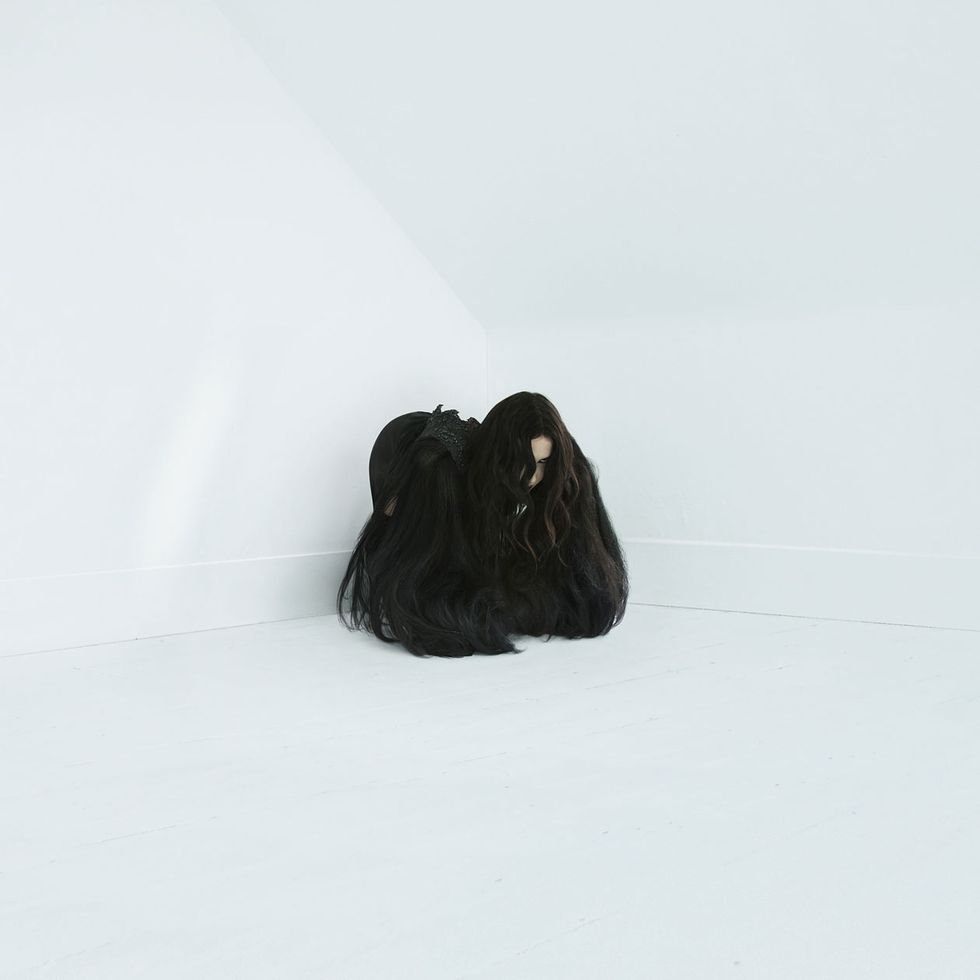
TIBIT: Hiss Spun was recorded by Converge’s Kurt Ballou at his GodCity Studio in Salem, Massachusetts, using mostly his collection of guitars, amps, and pedals. Overdrive and fuzz stomps were key.
The electric guitar plays a stronger role on Hiss Spun than on any of its predecessors. Was it your main writing tool this time around?
Yeah! It was a lot of Jess, our bandmate Ben Chisholm, and I getting together and just jamming—where I’d come in with a riff or idea, or just let Ben and Jess play and hit record and then go back to work and build off certain parts from the jamming to build a song. Once we had songs together, we’d send them to Troy Van Leeuwen, to write lead parts for. The intent was definitely to keep it more of a band album and more of a rock album.
I caught the tour you opened for Queens of the Stone Age and I really love that a creative relationship spawned from it. Can you tell me what it is about Troy’s playing that made him right for this record?
That tour with Queens was really important for me. At that time, I was thinking about going in a more acoustic direction again, and as soon as I was with those guys, hearing them play some of my favorite rock songs night after night and just seeing how much fun and energy they have, I decided I wanted to make heavy music and rock again. It sent me back on that path. Queens has been one of my favorite bands for a long time, and Troy is one of my favorite players, and we really hit it off on that tour. Troy and Ben kept in touch after that tour as well.
So once a few of these songs came together between Jess and I, Troy immediately came to mind as the right player for them. I really wanted to have some big guitar leads on it, and I left space specifically for him to do so—like on “16 Psyche,” there’s a big chunk of space that was left for Troy, which I’d thought about when I initially wrote the song. These songs also have some really twisted emotions in them, and I knew that Troy would understand that and where I’m coming from and channel it the right way. And he did!
Where are you coming from as a player?
I tend to say I’m self-taught because, for me, that speaks to a certain style of playing that’s sort of wild and weird, and more intrinsic and not necessarily something that can be learned. When I was younger, I was envious of people that were classically trained on an instrument, but I just picked the guitar up to write songs and I taught myself to play really by writing songs, and I didn’t really learn songs by other artists or anything like that. So for me, it was about finding the right sounds to my ears and moving things around in a way that simply felt right. That really guided the sound of my project for years. I’ve been blessed to play with a lot of other really talented guitar players over the years, but I like to always make sure there’s a lot of my own guitar playing on the records as well, because it’s something that comes from deep inside me and is instinctual.
A lot of the stuff I play on guitar is very circular. I tend to trip out on a pattern for a while and I meditate on it and go from there. I don’t really know how to define it easily. I don’t think anything I do is very easily defined—unfortunately for the rest of the world, because I know the world likes to put things in categories, but it doesn’t seem to work very well for me.
Wolfe used this black 1979 Gibson ES-335 to track most of Hiss Spun. “It’s very loud, but also very dynamic, which makes it great for fingerpicking,” she explains. Wolfe also has a 2014 ES-335 in sunburst, which she describes as the best guitar she’s ever had. Photo by Tim Bugbee/Tinnitus Photography
How did you get into fingerstyle playing?
It’s a style that came naturally. I’m really into an old blues player named Abner Jay and his style was pretty influential to me. He has this great mix of picking with his fingers and strumming that I love. I tend not to use a pick very often, but I still incorporate picking and strumming in the same song, even if I’m just using my fingers.
Do you have any other guitar influences?
A lot of the stuff Jack White has done, especially his style of playing in the White Stripes. That was really influential to me. I’d definitely say Queens of the Stone Age has been a major influence on my playing.
Lindsey Buckingham from Fleetwood Mac is probably one of my earliest important influences—both vocally and as a guitarist. My dad and stepmom had a VHS of a live performance Fleetwood Mac did in 1997 called The Dance, and Lindsey did a version of “Big Love” that was just him and his guitar, and the way he plays is so unique and dynamic, and his voice is just so raw, beautiful, and full of emotion. That performance had a really big impact on me as a younger person starting to play music. I actually saw him perform live not that long ago and it was amazing. His solo guitar parts are incredible.
I’m also a big Ozzy Osbourne fan. While it’s a totally different style, Randy Rhoads is one of my favorites. As I get older, I’ve learned to really appreciate over-the-top lead guitar.
Do you have any kind of specific philosophy to arranging guitars around the big synths and electronic sounds on your albums?
A lot of it happens at the same time, so I think it happens pretty naturally. The song “Particle Flux” is actually Ben playing guitar while I directed, and he was playing through a Red Panda Particle pedal. So while that sounds like an electronic song, it’s actually guitar. We had that pedal kicking around the studio and the song developed from ideas played through it.
As Ben played different ideas, we would go, “That one’s good and that one’s good. Let’s put those together.” And we’d build a pattern that feels more electronic out of those parts, and Ben is really good at building beats and programs out of musical content like that. A lot of the time the guitar is actually incorporated in the “synth” sounds, so you might not even realize that there’s guitar on a track, but it’s actually the foundation.
That’s really unexpected. Are there other effects pedals that you found majorly inspiring?
The Electronic Audio Experiments Longsword! I played in Boston a couple of years ago and one of the guys from that company came out to our soundcheck and we chatted about pedals and he gave me a Longsword. That pedal became a staple for me when I write new music, so it ended up on this record a lot. It’s just a really functional yet unique distortion pedal.
On [2015’s] Abyss, the Death By Audio Apocalypse was a pedal I was super drawn to and has become one of my absolute favorites. I have it on my board at all times and I just ordered a second one in case anything happens to it on the road, so I have an instant backup. It’s just the best and heaviest fuzz pedal that still has some definition to it. I also really love the EarthQuaker Devices Talons. I mostly play around with distortion and fuzz. I use an EarthQuaker Devices Disaster Transport for some weird delay stuff, and the Dispatch Master as well. I really love that pedal.
The gear stash at GodCity is pretty legendary—particularly Kurt Ballou’s wall of amps. What amps from his bunker did you end up using to track the album?
We went through a ton of amps, but an old Gibson Titan from the ’60s made it onto the record a lot. We also did a lot through a vintage Laney Klipp through an Emperor 6x12 cab, which was a great combination.
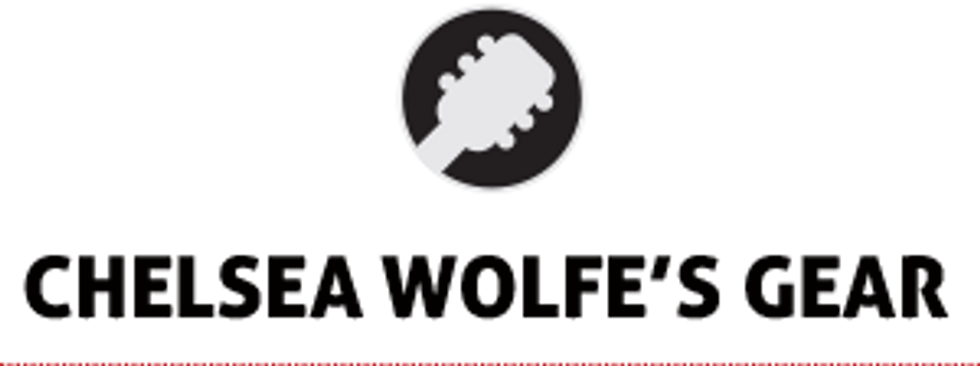
Guitars
2013 Gibson ES-335
1979 Gibson ES-335
Fender Jazzmaster with Stratocaster neck
Kurt Ballou’s Fender Mustang body with Dean neck and a bridge humbucker
Amps
1960s Gibson Titan
1970s Laney Klipp
Emperor 6x12 cab
Fender Bassbreaker 45
Effects
Death By Audio Apocalypse fuzz
EarthQuaker Devices Speaker Cranker overdrive
EarthQuaker Devices Talons overdrive
EarthQuaker Devices Acapulco Gold power amp distortion
DigiTech Supernatural Ambient Verb
MXR Carbon Copy Bright
Strings and Picks
Ernie Ball (.011–.048)
D’Angelico by D’Addario Electrozinc (.011–.049)
There is a mountain of guitar on “Static Hum.” Can you tell me how that track was constructed and what we’re hearing in the guitars?
That’s actually one of my guitar songs, so I played that main riff. I wanted to incorporate the demo version of it as well, because I liked the tone on the demo so much. Since I tracked them in the same tempo, I just added the original demo version as another doubled track. Ben didn’t come out to the studio [for that track], but emailed us his parts, and we arranged them from there and ran them through some pedals to tweak them and give them a more cohesive feel to the other parts.
The word “hiss” in the album title is referencing the intense white noise in the universe. Carl Sagan said that 1 percent of TV and radio static is remnants from the Big Bang, and I thought that was a kind of romantic idea and took that concept into the album, so there’s a lot of static, white noise, and guitar amp hiss on the album to add that concept in. “Static Hum” and “Vex” in particular have moments of guitar and amp noise that’s just me sampling the amp hissing and humming while it’s sitting on.
The way feedback and hum is embraced and used as a creative tool makes the record feel very alive.
For me, as the musical director and curator for this project, there’s all these tiny little sounds and moments that I know are really important to the final vision. Every little sound and bit of tone is important. Especially stuff like that.
What guitars did you use on the album?
I used my Gibson ES-335 a lot. I actually have two: a stock 2014 model in sunburst, which is just the best guitar I’ve ever had—every time I pick it up, I want to play it forever—and a really great one from 1979 that I got recently, which is finished in black. The ’79 has a lot of crackling and checking on the finish, which looks great, and I used the vintage one for most of the tracking this time because it’s very loud, but also very dynamic, which makes it great for fingerpicking.
I also used this strange monster of a parts guitar that Kurt has that’s got a Dean neck on a Fender Mustang body, with one humbucker in the bridge. I picked it up and loved the neck on it, and it sounded great, so we used it a bunch. And I also used my Fender Jazzmaster a lot. It has a Strat neck on it. So there were a couple of mutant guitars on this album.
I often say that guitars have songs inside of them, and I really believe that. The first guitar I had was an old classical that belonged to my mom when she was a teenager. I found it in the garage. I didn’t really know how to play it. I just kinda picked it up and I feel like it gave me songs and taught me how to play. There’s something metaphysical and spiritual about certain guitars, you know?
How do you write heavy, down-tuned guitar parts while avoiding the clichés of doom metal?
I’m not overthinking it, really. I’m definitely influenced by some very doom-oriented shit. Like I said, I’m a huge Ozzy fan. I’m a massive Black Sabbath fan. I love bands like Swans and Sunn O))), but my formative years were in the late ’90s/early aughts, and I went back to a lot of that stuff on this album—things like Nine Inch Nails, Soundgarden, Smashing Pumpkins. I think there’s a lot of that influence on this record. Again, I always approach things in my own way and I’m not trying to sound a certain way. I was just listening to a lot of that at the time I was writing this stuff. I should also mention there was a lot of trip-hop influence involved on this one. I was also listening to a lot of Tricky, Portishead, and Massive Attack back then.
As a guitarist, what did you take away from working with Kurt Ballou?
More than working in the studio with him, playing alongside him with Converge while doing the Blood Moon project last year was the real lesson. There’s no specific thing, but I think it’s really good to put yourself in a situation where you’re playing with players that are better than you and that you admire. Just playing alongside someone that’s great and that you admire makes you want to work harder as a player.
With her black 1979 Gibson ES-335, Chelsea Wolfe and her Hiss Spun band—drummer Jess Gowrie, Ben Chisholm on bass, and Queens of the Stone Age guitarist Troy Van Leeuwen—dive into a dark maelstrom of sound and emotions in the official video for “16 Psyche.”
“A lot of what I’ve been doing over the last eight to 10 years has been using single-coil pickup guitars: Jazzmasters and Teles,” says Van Leeuwen. “For me, those guitars are always able to cut.” Photo by Debi Del Grande
Troy Van Leeuwen: When the Going Gets Weird, the Weird Turn Pro
Troy Van Leeuwen is known for his high-profile role as the suited-and-booted lead guitarist of world-shaking, desert-rockers Queens of the Stone Age. His resume is rife with projects that live in the rock realm, yet are defined by unconventional guitar work. From bands like Sweethead, Failure, and A Perfect Circle to supergroup Gone Is Gone to backing up Iggy Pop on the Post Pop Depression album and tour with fellow Queens members Josh Homme and Dean Fertita, Van Leeuwen’s playing always gives songs the extra dimension they might otherwise be missing. Truly an unsung hero of supportive guitar playing, Van Leeuwen proved to be perfect to infuse Hiss Spun with the angular leads and heavy texture that are his calling card. We asked Van Leeuwen about his work on Hiss Spun.
When Wolfe approached you to play on the record, were you given much in the way of instruction or direction?
Ben Chisholm and I were trading songs. I gave him a Sweethead song to work on and he did some programming and added some synth parts, and I put that one on the last record. Then Ben sent me a couple of instrumentals to work with—not necessarily intended for Chelsea’s record at the time, as far as I know—and I recorded some ideas for those at home and he liked what I did, so he sent a couple more! So it was really a very casual thing.
By the time you hit the ground at GodCity, things were sketched out?
I had a very basic idea. Some of the things I recorded at home actually wound up sticking, but when I got to GodCity to track the rest of the stuff, I listened and didn’t really decide on parts and ideas until I felt it, because I like to feel stuff as it comes. So I did three songs there, and I just jumped in the fire and went after it. Ben and Chelsea were both there and it was very collaborative. There was a little bit of experimentation while tracking, but we came up with things we all liked.
You’ve done a lot of work as a texture-oriented lead player, and this record definitely highlights your strengths in that style. Can you outline your core approach?
A lot of what I’ve been doing over the last eight to 10 years has been using single-coil pickup guitars: Jazzmasters and Teles. For me, those guitars are always able to cut, so that’s usually the first thing I grab and they usually do the job.
Along with this album, a lot of what I’ve done on Queens’ music and the Gone Is Gone record involves heavy reverb, and I’m getting into that way more these days. Usually I have some kind of signal chain that has enough bite and sustain to work, but not too much distortion. And I love feedback! On Chelsea’s record, I was in the room with the amps a lot, so there’s a lot of natural feedback that I think worked well with her music.
Did you bring any of your own gear for the sessions?
Kurt had everything I needed, really. Any guitar I needed—and he has that great amp selection... tons of pedals. I did bring the prototypes for my Dr. No signature pedals, and I brought an Eventide H9, which is one of those “don’t leave home without it” pieces. I also brought an Electro-Harmonix Superego, which I used on “16 Psyche” and “Vex.” But for the most part, everything Kurt had there was well within my comfort zone and stuff that I’d used before over the years. I used Kurt’s Jazzmaster, a 1965 with blocks and binding—which is what my signature Fender is based on—so I felt very at home.
Can you tell me about your signature pedals?
Yeah! One is called the Raven, and that’s a filter and boost—like a really extreme kind of wah pedal without the rocker pedal. You set it at a certain frequency and roll with it like that, and that’s tied to a clean volume boost. That pedal also has a 3-way switch in the middle that you can adjust within the frequency range with your foot—sort of my ideal cocked wah thing with a boost section. The other one is an Octavia-style fuzz—very old school. It’s basically a hardwired Foxx Tone Machine, and it’s one of those fuzz pedals that when you step on it, it’s gigantic. That one’s on “Spun” a lot.
You’ve always demonstrated a really strong ability to find something unique to say with the guitar within heavily layered music. Any advice for players looking to pull that trick off?
It really took me a while to figure this out, but—especially when it comes to heavy music—I like to cut the low end when I’m doing anything over-the-top. Obviously heavy guitars have to chunk and have some weight, but cutting the low end really makes things sit better and mix better. That comes from years of learning how to mix and learning how to track. I used to make the mistake that more low end is what you need to make things heavy, but layering is all about finding frequencies that work and sit right.
What was it like to work with Kurt Ballou?
I’m always up for working with different people from different musical worlds. Each time I collaborate or work with anyone, it’s an opportunity to learn something. For me, hearing his records and learning how he works was really great. It was a cool exchange. His opinions are really brave. Any time I can work outside of what I typically do, it’s a big bonus. Any time Kurt suggested something, he was typically right!
